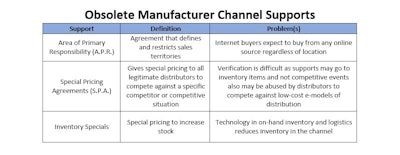
 Scott Benfield
Scott BenfieldIn the first part of this two-part series, we discussed the rise of five new distribution models that use e-commerce and digital technology to thin-slice the value chain. These firms offer great prices for truncated product and service offerings and they are growing; often at double digits. In this installment, we review common channel supports for distributors. These supports fall under the function of sales promotion and channel management. They have been found in manufacturer/distributor channel relationships for decades. However, as digitalization increases, they often become obsolete or counter-productive.
When the Channel Changes, Marketing Has Work to Do
Many of the supports that distributors receive are based on a common distribution model where independent companies take title to goods for an average of 3-4 months, store them in a local warehouse, and sell them through inside and outside sales forces to qualified users who, in turn, install or resell the items. The problem with this model is that it is becoming less and less viable as it is too costly.
Sales support for a distributor transaction costs $40 to $50 for outside and inside support. This cost, for e-commerce transactions, is a few dollars. Additionally, numerous brick and mortar locations were part of a transportation and inventory management structure governed by land-line technology. Today, because of modern, real-time logistics and inventory tracking, the plethora of branch locations, the existing old-style wholesale distribution infrastructure is inefficient.
Many manufacturer channel policy and sales support programs are based on the old dynamics of a sales driven relationship backed by numerous branch locations with burgeoning local inventory. They are largely out of tune with the realities of digital commerce.
In Exhibit 1, we have listed several of the more common programs and policies that manufacturers have supported in decades past. We discuss them in the remainder of this installment.
Obsolete Distributor Supports
Internet buyers expect to purchase from the online entity that they most value regardless of location. Area of Primary Responsibility (A.P.R.) restrictions are relics from years past when the value proposition of the channel was dependent on branch locations and post-sales service was the obligation of “in A.P.R.” distributors. Geography as a defining value chain element has diminished for most items including “emergency need” inventory. Today, with modern logistics, A.P.R. restrictions irritate the internet buyer and can cost supporting manufacturers the end-user sale.
Special Pricing Arrangements or S.P.A.’s emerged in the late 1990’s in the construction products sectors especially electrical and plumbing products. In one shape or form, pricing supports have been a part of distribution for decades but they were limited, in the past, by the restrictions and damages from the Robinson-Patman Act. The Act requires proportional access to pricing programs and discounts and damages can be severe. In recent times, where the Act has been challenged, it is much less likely to be found damaging to any one distribution company.
S.P.A.’s give pricing support to distributors to counter a competitive situation. The competitive event is, generally, market-based and supported by distributor sales invoices. Unfortunately, because of the volume of S.P.A’s granted, it is unlikely that manufacturers can effectively police all market events that use the special pricing and unlikely that all discounts are used as intended.
 Exhibit 1
Exhibit 1Price discounts in distribution markets, based on our research, are packed with a large incentive to cheat. Distribution is a thin margin business and financial profitability can be upset by any number of unforeseen events. Hence misuse of pricing programs is tempting.
Because of the alternative models of distribution of which the majority are low-cost competitors, the likelihood that S.P.A.’s are used to combat a low-cost channel is significant. The responsibility of combating low-cost distribution is not that of the manufacturer but the distributor. Hence, we see increased S.P.A.’s as risky for the manufacturer. It can signal the increase in low-cost, alternative distribution models and the need for the manufacturer to solicit new distribution partners who make use of e-commerce to reduce the cost to market.
The final obsolete channel support is called inventory specials. In these programs, sku discounts are given to increase the distributor’s inventory of a product or product family. This is often reserved for new products, however, there are exceptions including products that distributors are unfamiliar with because of changes in market conditions. The problem with inventory loading programs is that they are meant for a time when having product, in bulk, and close to the market meant increased sales. Today, with transparent supply chains through e-commerce and advanced logistics, these programs are counterproductive. They often harm asset productivity and don’t increase sales.
Not all manufacturer supports, including those cited, are misplaced. There are many competitive situations where these and similar programs are needed. Most programs, however, are short term incentives and do not answer the fundamental changes from digitalization of the distribution sector.
Suggestions for Manufacturers
The two part series on channels follows multi-year research into the changes in the $3 Trillion Dollar in sales North American Durable Goods sector. Digitalization of commerce offers the chance to take significant costs from existing channels and develop new models of business that are less costly and often deliver a higher quality service. Channel management as a subject has been, more or less, dormant for the past twenty years as the existing distribution model has been successful in moving forward into the value chain. Today, however, there are new models of distribution that slice apart the value chain and are increasingly successful over the dominant model which is burdened with offering too many products and services.
Channel managers should familiarize themselves with the new models and review their channels for new entrants. At the very least, they should survey distributor customers to gauge their online buying habits. As online commerce grows in the distribution sector, many of the channel supports and controls that are currently used will become counterproductive. Marketing execs should take time to carefully review their channel policies in light of significant changes from online commerce.
Scott Benfield is a consultant for B2B durable goods channels through his consulting firm, Benfield Consulting.



















